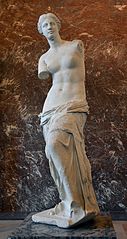Our website is made possible by displaying online advertisements to our visitors.
Please consider supporting us by disabling your ad blocker.
Hellenistic art
the Venus de Milo, discovered at the Greek island of Milos, 130–100 BC, Louvre
the Winged Victory of Samothrace, from the island of Samothrace, 200–190 BC, Louvre
Pergamon Altar, Pergamon Museum, Berlin.
Hades abducting Persephone, fresco in the royal tomb at Vergina, Macedonia, Greece, c. 340 BC
| History of art |
|---|
Hellenistic art is the art of the Hellenistic period generally taken to begin with the death of Alexander the Great in 323 BC and end with the conquest of the Greek world by the Romans, a process well underway by 146 BC, when the Greek mainland was taken, and essentially ending in 30 BC with the conquest of Ptolemaic Egypt following the Battle of Actium. A number of the best-known works of Greek sculpture belong to this period, including Laocoön and His Sons, Dying Gaul, Venus de Milo, and the Winged Victory of Samothrace. It follows the period of Classical Greek art, while the succeeding Greco-Roman art was very largely a continuation of Hellenistic trends.
The term Hellenistic refers to the expansion of Greek influence and dissemination of its ideas following the death of Alexander – the "Hellenizing" of the world,[1] with Koine Greek as a common language.[2] The term is a modern invention; the Hellenistic World not only included a huge area covering the whole of the Aegean Sea, rather than the Classical Greece focused on the Poleis of Athens and Sparta, but also a huge time range. In artistic terms this means that there is huge variety which is often put under the heading of "Hellenistic Art" for convenience.
One of the defining characteristics of the Hellenistic period was the division of Alexander's empire into smaller dynastic empires founded by the diadochi (Alexander's generals who became regents of different regions): the Ptolemies in Egypt, the Seleucids in Mesopotamia, Persia, and Syria, the Attalids in Pergamon, etc. Each of these dynasties practiced a royal patronage which differed from those of the city-states. In Alexander's entourage were three artists: Lysippus the sculptor, Apelles the painter, and Pyrgoteles the gem cutter and engraver.[3] The period after his death was one of great prosperity and considerable extravagance for much of the Greek world, at least for the wealthy. Royalty became important patrons of art. Sculpture, painting and architecture thrived, but vase-painting ceased to be of great significance. Metalwork and a wide variety of luxury arts produced much fine art. Some types of popular art were increasingly sophisticated.
There has been a trend in writing history to depict Hellenistic art as a decadent style, following the Golden Age of Classical Greece. The 18th century terms Baroque and Rococo have sometimes been applied to the art of this complex and individual period. A renewed interest in historiography as well as some recent discoveries, such as the tombs of Vergina, may allow a better appreciation of the period.
- ^ Pedley 2012, p. 339
- ^ Burn 2005, p. 16
- ^ Pollitt 1986, p. 22
Previous Page Next Page






